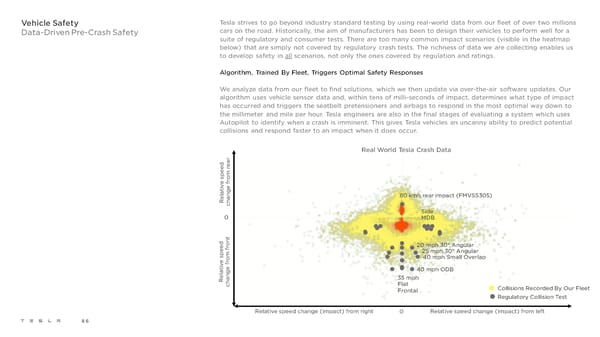Vehicle Safety Tesla strives to go beyond industry standard testing by using real-world data from our fleet of over two millions Data-Driven Pre-Crash Safety cars on the road. Historically, the aim of manufacturers has been to design their vehicles to perform well for a suite of regulatory and consumer tests. There are too many common impact scenarios (visible in the heatmap below) that are simply not covered by regulatory crash tests. The richness of data we are collecting enables us to develop safety in all scenarios, not only the ones covered by regulation and ratings. Algorithm, Trained By Fleet, Triggers Optimal Safety Responses We analyze data from our fleet to find solutions, which we then update via over-the-air software updates. Our algorithm uses vehicle sensor data and, within tens of milli-seconds of impact, determines what type of impact has occurred and triggers the seatbelt pretensioners and airbags to respond in the most optimal way down to the millimeter and mile per hour. Tesla engineers are also in the final stages of evaluating a system which uses Autopilot to identify when a crash is imminent. This gives Tesla vehicles an uncanny ability to predict potential collisions and respond faster to an impact when it does occur. Real World Tesla Crash Data r a e eed r p m o r e sf v i e t a ng 80 kmh rear impact (FMVSS305) ela R h c Side 0 MDB nt o 20 mph 30°Angular r eed f 25 mph 30°Angular p m 40 mph Small Overlap o e sr v f i t e 40 mph ODB a ng ela 35 mph R h Flat c Collisions Recorded By Our Fleet Frontal Regulatory Collision Test Relative speed change (impact) from right 0 Relative speed change (impact) from left 86
 Tesla 2021 Impact Report Page 85 Page 87
Tesla 2021 Impact Report Page 85 Page 87